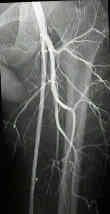- Discussion:

- largest branch of femoral artery in femoral triangle;
- arises on lateral side of femoral artery, 3-5 cm below inguinal lig;
- passes on surface of pectineus & adductor brevis;
- passes posteriorly, lying behind femoral artery & vein on medial
side of femur, passing behind tendon of adductor longus;
- courses to lie directly on adductor magnus, perforating branches pass
between edge of femur and tendinous insertion of add magnus
- Branches:
- lateral circumflex
- medial circumflex femoral artery
- branch to adductor magnus
- perforating branches
- terminal branch (4 th perforator)
- Trauma to Profunda:
- ischemia of foot is uncommon unless there is underlying significant atherosclerotic disease of superficial femoral artery;
- many injuries to the profunda are initially not detected & present as late false aneurysms;
- profunda femoris artery is at risk of injury during orthopedic procedures from perforation by metallic screws;
- ligation of vessel for proximal injuries is contraindicated because this may be important collateral pathway, esp in atherosclerotic population
Vascular proximity: is it a valid indication for arteriography in asymptomatic patients.
Simulation of compartment syndrome by rupture of the deep femoral artery from blunt trauma.
Illustrated Encyclopedia of Human Anatomic Variation: Deep Circumflex Iliac Artery
Illustrated Encyclopedia of Human Anatomic Variation: Femoral Artery
Illustrated Encyclopedia of Human Anatomic Variation: Profunda Femoris Artery
Illustrated Encyclopedia of Human Anatomic Variation: Medial and Lateral Femoral Circumflex Arteries

